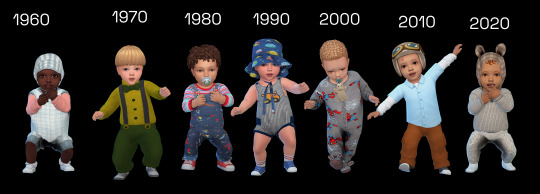#i hate 2010s fashion sm cause why did i wear a blazer for my tenth birthday
Text




The 1960s, particularly towards the end of the decade, were all about funky colours and patterns. Stripes, plaids and contrasting colours were common in infant clothing.
Plaids remained in fashion through to the 1970s, though the neon like colours of the 60s started to fall out of favour, being replaced by browns, oranges and greens. Knit and crochet handmade pieces also grew in popularity as a counterculture response to the mass manufacturing of synthetic clothing.
As a result of this mass manufacturing, the popularity of clothing embroidered with characters from children's media such as "Sesame Street" grew and continued to grow through to the 1980s. During the 1980s, perhaps due to the rise of athleisure, infant clothing also became much more casual with t-shirts and polos instead of button down shirts for instance.
The 1990s continued many trends from previous decades. Clothing was casual and colourful; onesies, vests, baby grows all were more commonplace. Denim also became increasingly popular, reflecting adult styles. This stayed very similar during the 2000s, along with newer trends like logomania, miniskirts, flares etc.
By the 2010s, "casual" had been replaced with "business casual" and even babies weren't spared. Collared shirts , trousers or knee length shorts was common for baby boys and for baby girls, dresses with leggings as well as leggings and a top were in fashion. Helmet therapy to reduce head flattening also became more common.
The 2020s began with a global pandemic leading to the rise in a preference for handmade and natural clothing as well as beige-mania. Infants are usually dressed comfortably in stretchy and simple two piece matching sets or onesies. Clothing itself is normally gender neutral, though "pink for girls;blue for boys" still remains common place and hair bows for baby girls remain popular.
#sims 4 decades challenge#sims 4 lookbook#infant lookbook#infant cc#resources#lookbook#i hate 2010s fashion sm cause why did i wear a blazer for my tenth birthday#it was hot pink as well 😭😭
93 notes
·
View notes